Monopole Antenna Miniaturization with Magneto-Dielectric Material Loading Combined with Metal Parasitic Element
Abstract
:1. Introduction
2. Magneto-Dielectric Material (MDM) Properties
3. Planar Monopole Antenna Loaded with MDM
3.1. Specifications and Goal
3.2. Impact of the MDM on Planar Monopole Antenna
3.3. Modifying the Antenna Shape in Order to Increase the Permeability Effect
3.4. Adding Metallic Plates in Order to Optimize the Permittivity Effect
4. Matching Network and Antenna Prototype Design
4.1. Matching Network Design with Real Frequency Technic (RFT)
4.2. Antenna Prototype Realisation
5. Results
5.1. Impedance Measurements
5.2. Antenna Efficiency Measurement
6. Discussion
Author Contributions
Funding
Acknowledgments
Conflicts of Interest
References
- Hansen, R.C.; Burke, M. Antennas with magneto-dielectrics. Microw. Opt. Technol. Lett. 2000, 26, 75–78. [Google Scholar] [CrossRef]
- Farzami, F.; Forooraghi, K.; Norooziarab, M. Miniaturization of a Microstrip Antenna Using a Compact and Thin Magneto-Dielectric Substrate. IEEE Antennas Wirel. Propag. Lett. 2011, 10, 1540–1542. [Google Scholar] [CrossRef]
- Mosallaei, H.; Sarabandi, K. Magneto-Dielectrics in Electromagnetics: Concept and Applications. IEEE Trans. Antennas Propag. 2004, 52, 1558–1567. [Google Scholar] [CrossRef] [Green Version]
- Li, Y.; Feng, Q. A Compact UHF Planar Monopole Antenna Using Magnetodielectric Ferrite Substrate. In Proceedings of the 2019 PhotonIcs & Electromagnetics Research Symposium—Spring (PIERS-Spring), Rome, Italy, 17–20 June 2019; pp. 2058–2061. [Google Scholar] [CrossRef]
- Zheng, Z.; Wu, X. A Miniaturized UHF Vivaldi Antenna With Tailored Radiation Performance Based on Magneto-Dielectric Ferrite Materials. IEEE Trans. Magn. 2020, 56, 1–5. [Google Scholar] [CrossRef]
- Pinsakul, A.; Promwong, S. Artificial Magneto-Dielectric Metamaterial with Microstrip Antenna for Wireless Applications. In Proceedings of the 2019 5th International Conference on Engineering, Applied Sciences and Technology (ICEAST), Luang Prabang, Laos, 2–5 July 2019; pp. 1–4. [Google Scholar] [CrossRef]
- Zheng, Z.; Yin, P.; Feng, Q. Low-Profile and Broadband Ferrite-Loaded Antenna for VHF/UHF Applications. In Proceedings of the 2021 International Applied Computational Electromagnetics Society (ACES-China) Symposium, Chengdu, China, 28–31 July 2021; pp. 1–2. [Google Scholar] [CrossRef]
- Jain, P.; Bansal, S.; Kumar, N.; Kumar, S.; Gupta, N.; Singh, A.K. Magneto-dielectric properties of composite ferrite based substrate for UHF band microstrip antenna. In Proceedings of the 2017 Progress in Electromagnetics Research Symposium—Spring (PIERS), St. Petersburg, Russia, 22–25 May 2017; pp. 981–983. [Google Scholar] [CrossRef]
- Adhiyoga, Y.G.; Rahman, S.F.; Apriono, C.; Rahardjo, E.T. Miniaturized 5G Antenna with Enhanced Gain by Using Stacked Structure of Split-Ring Resonator Array and Magneto-Dielectric Composite Material. IEEE Access 2022, 10, 35876–35887. [Google Scholar] [CrossRef]
- Sorocki, J.; Piekarz, I.; Slomian, I.; Gruszczynski, S.; Wincza, K. Realization of Compact Patch Antennas on Magneto-Dielectric Substrate Using 3D Printing Technology with Iron-Enhanced PLA Filament. In Proceedings of the 2018 International Conference on Electromagnetics in Advanced Applications (ICEAA), Cartagena De Indias, Colombia, 10–14 September 2018; pp. 185–188. [Google Scholar] [CrossRef]
- Chzhan, A.V.; Podorozhnyak, S.A.; Zharkov, S.M.; Gromilov, S.A.; Patrin, G.S. Induced magnetic anisotropy of Co-P thin, films obtained by electroless deposition. J. Magn. Magn. Mater. 2021, 537, 168129. [Google Scholar] [CrossRef]
- Xu, Z.; Cui, J.; Zhang, C.; He, D.; Wang, T. High-frequency magnetic properties and micro-magnetic structure of Co2W-type ferrite with Bi2O3 addition for potential antenna applications. J. Magn. Magn. Mater. 2022, 562, 169815. [Google Scholar] [CrossRef]
- Kabalan, A.; Sharaiha, A.; Tarot, A.-C. Electrically Small Wideband Monopole Antenna Partially Loaded with Low Loss Magneto-Dielectric Material. Magnetism 2022, 2, 17. [Google Scholar] [CrossRef]
- Finet, T.; Sharaiha, A.; Tarot, A.-C.; Pouliguen, P.; Potier, P. Low profile folded monopole antenna higly miniaturized by the use of low loss magnetodielectic materials in the VHF frequency band. In Proceedings of the 2021 IEEE Conference on Antenna Measurements & Applications (CAMA), Antibes Juan-les-Pins, France, 15–17 November 2021; pp. 202–203. [Google Scholar] [CrossRef]
- Batel, L.; Delaveaud, C.; Pintos, J.-F. Miniaturization of a Monopolar Wire-Plate Antenna Using Magneto-Dielectric Material. In Proceedings of the 2019 International Workshop on Antenna Technology (iWAT), Miami, FL, USA, 3–6 March 2019; pp. 91–94. [Google Scholar] [CrossRef]
- Vassallo, F.A.; Duncan, K.J.; Boylston, O.; Kratch, A.; Bennett, D.T.; Correa, J.C. UHF SATCOM antenna ground plane height reduction using Ni-Zn magneto-dielectric materials. In Proceedings of the 2016 USNC-URSI Radio Science Meeting, Fajardo, PR, USA, 26 June 2016–1 July 2016; pp. 93–94. [Google Scholar] [CrossRef]
- Mattei, J.-L.; Huitema, L.; Queffelec, P.; Pintos, J.; Minard, P.; Sharahia, A.; Jamnier, B.; Ferrero, F.; Staraj, R.; Souriou, D.; et al. Suitability of Ni-Zn Ferrites Ceramics with Controlled Porosity as Granular Substrates for Mobile Handset Miniaturized Antennas. IEEE Trans. Magn. 2011, 47, 3720–3723. [Google Scholar] [CrossRef]
- Mattei, J.-L.; le Guen, E.; Chevalier, A. Dense and half-dense NiZnCo ferrite ceramics: Their respective relevance for antenna downsizing, according to their dielectric and magnetic properties at microwave frequencies. J. Appl. Phys. 2015, 117, 084904. [Google Scholar] [CrossRef]
- MAGTREX 555. Available online: https://www.rogerscorp.com/advanced-electronics-solutions/magtrex-555-high-impedance-laminates (accessed on 5 October 2022).
- Ramahi, M.; Mittra, R. Design of a matching network for an HF antenna using the real frequency method. IEEE Trans. Antennas Propag. 1989, 37, 506–509. [Google Scholar] [CrossRef]
- Chu, L.J. Physical limitations of omni-directionalantennas. J. Appl. Phys. 1948, 19, 1163–1175. [Google Scholar] [CrossRef]
- Harrington, R.F. Effect of antenna size on gain, bandwidth, and efficiency. J. Res. Natl. Bur. Stand.-D Radio Propag. 1960, 64D, 1. [Google Scholar] [CrossRef]
- Best, S.R. A discussion on the quality factor of impedance matched electrically small wire antennas. IEEE Trans. Antennas Propag. 2005, 53, 502–508. [Google Scholar] [CrossRef]
- Rialet, D.; Sharaiha, A.; Tarot, A.-C.; Delaveaud, C. Estimation of the Effective Medium for Planar Microstrip Antennas on a Dielectric and Magnetic Truncated Substrate. IEEE Antennas Wirel. Propag. Lett. 2012, 11, 1410–1413. [Google Scholar] [CrossRef]
- Pucel, R.A.; Mass, D.J. Microstrip propagation on magnetic substrates—Part I: Design theory and part II: Experiment. IEEE Microw. Theory Technol. 1972, MTT-20, 304–308. [Google Scholar] [CrossRef]
- Carlin, H.; Yarman, B. The double matching problem: Analytic and real frequency solutions. IEEE Trans. Cir-Cuits Syst. 1983, 30, 15–28. [Google Scholar] [CrossRef]
- Krouka, W.; Sarrazin, F.; Sol, J.; Philippe, B.; Elodie, R. Biased Estimation of antenna Radiation Efficiency within Reverberation Chambers Due to Unstirred Field: Role of Antenna Stirring. IEEE Trans. Antennas Propag. 2022, 70, 9742–9751. [Google Scholar] [CrossRef]


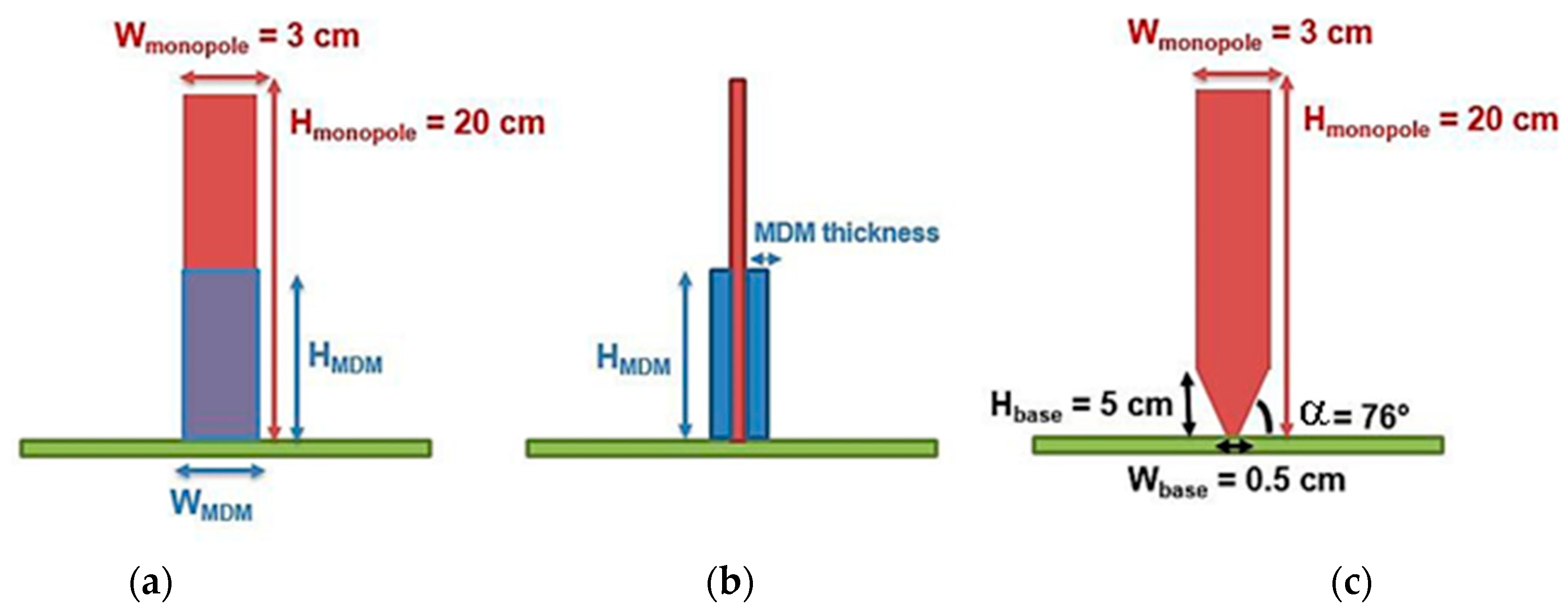

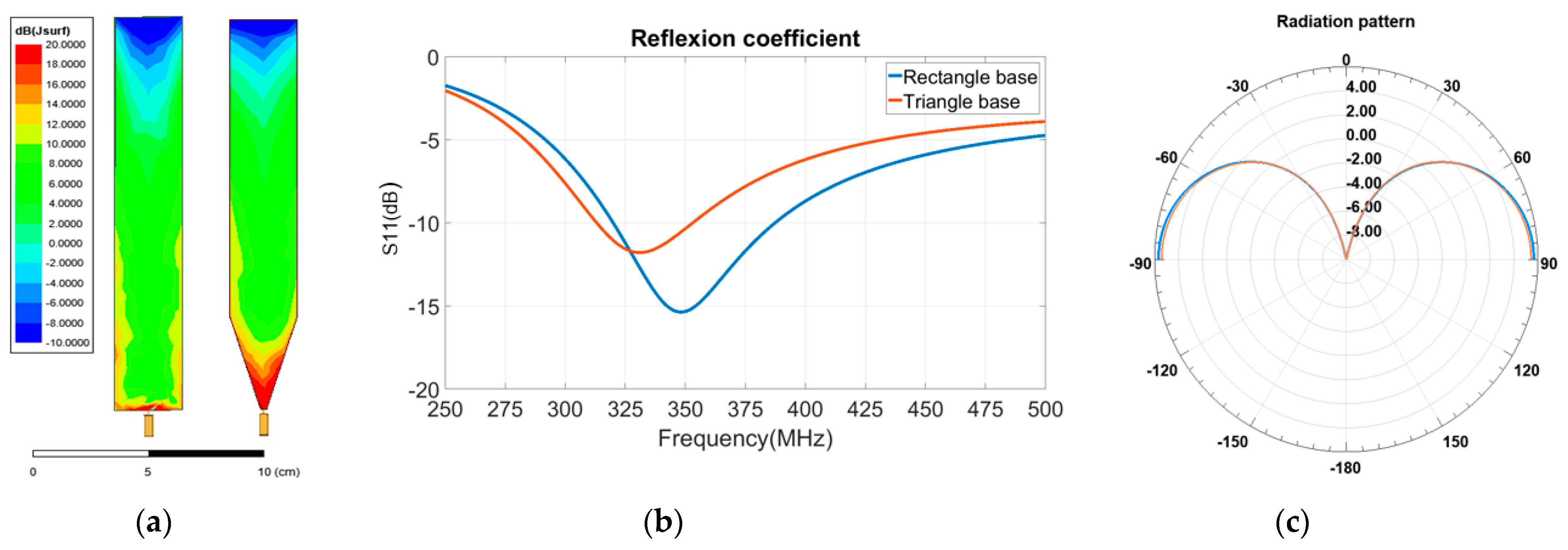


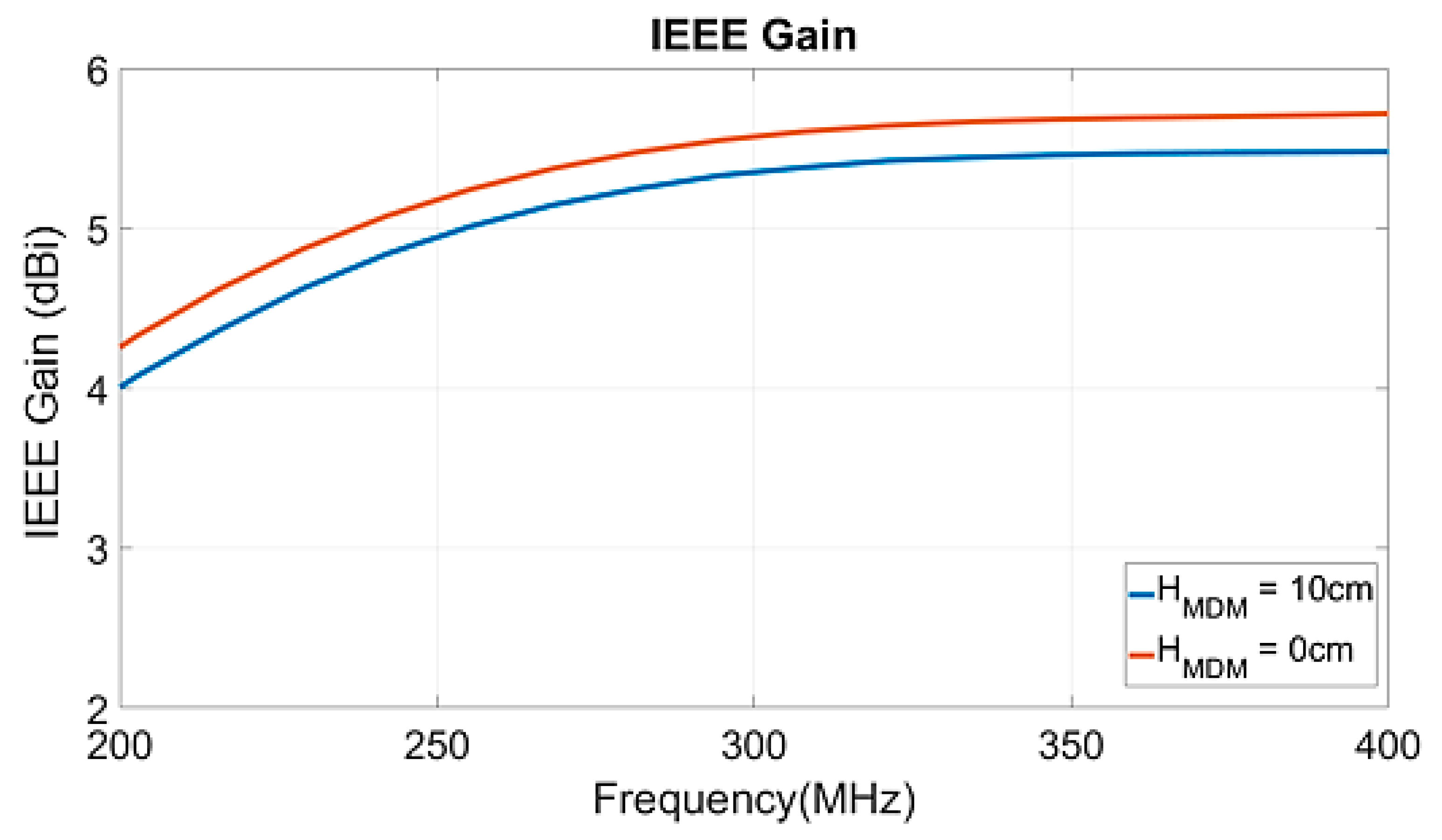
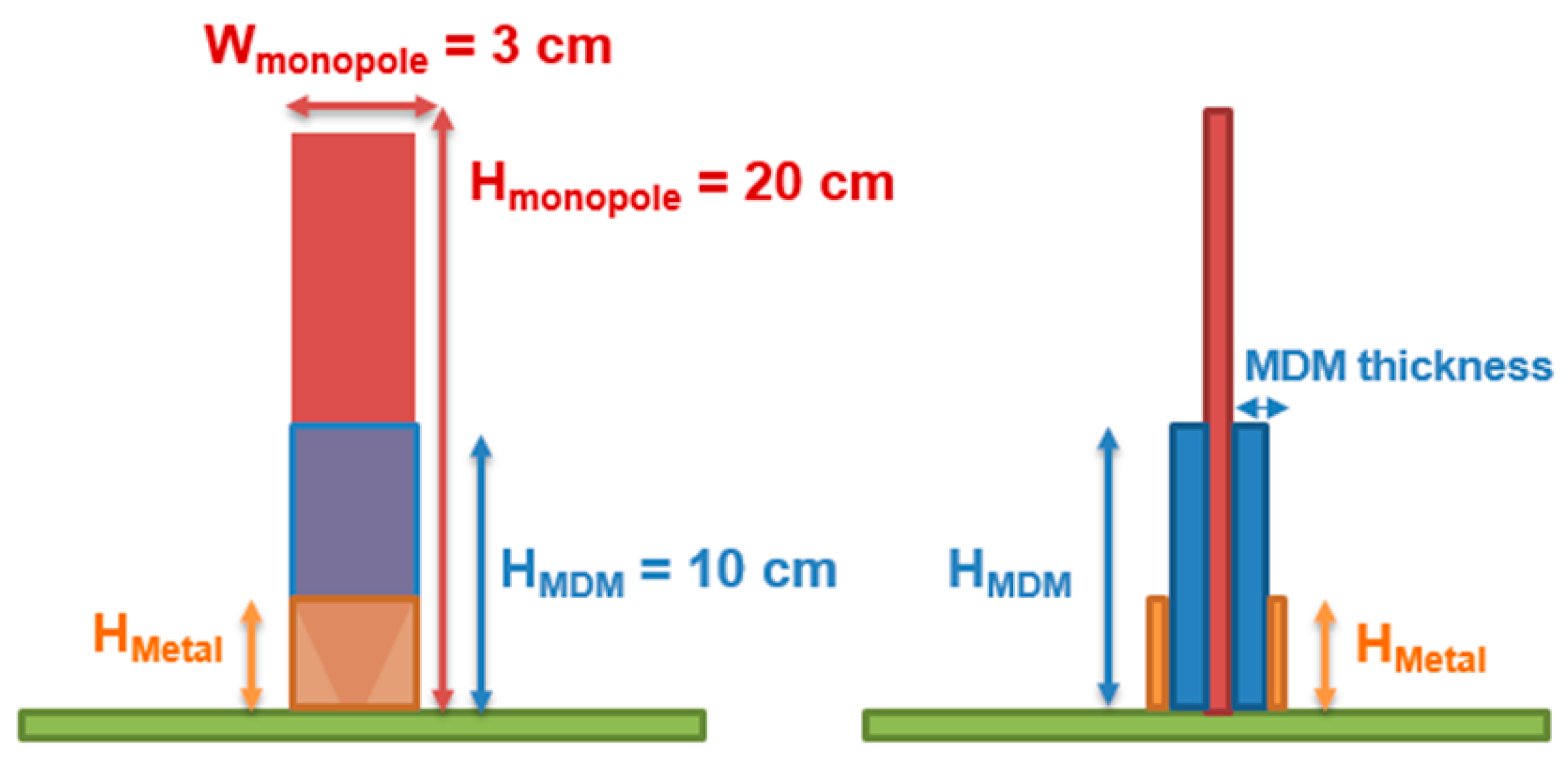


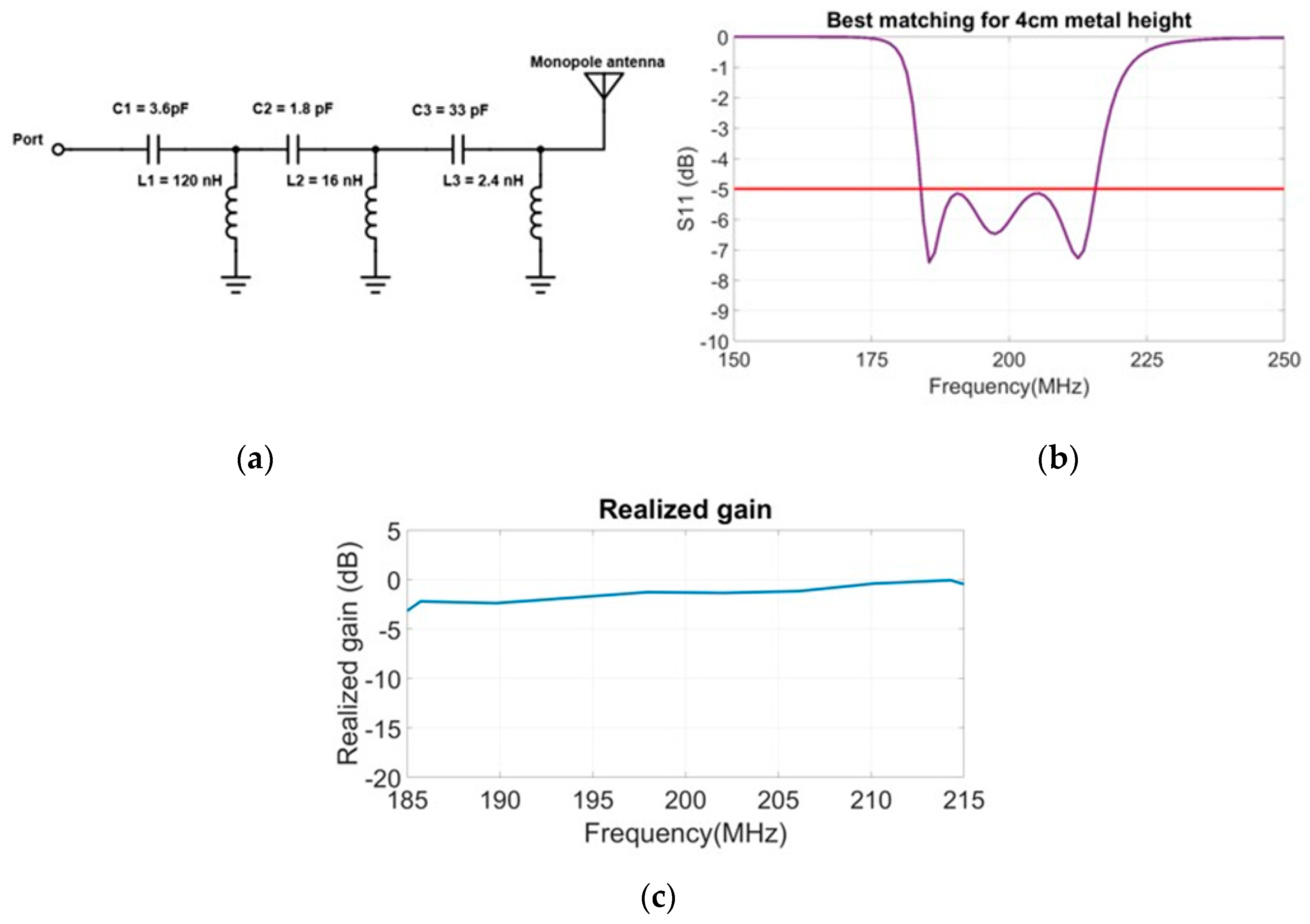
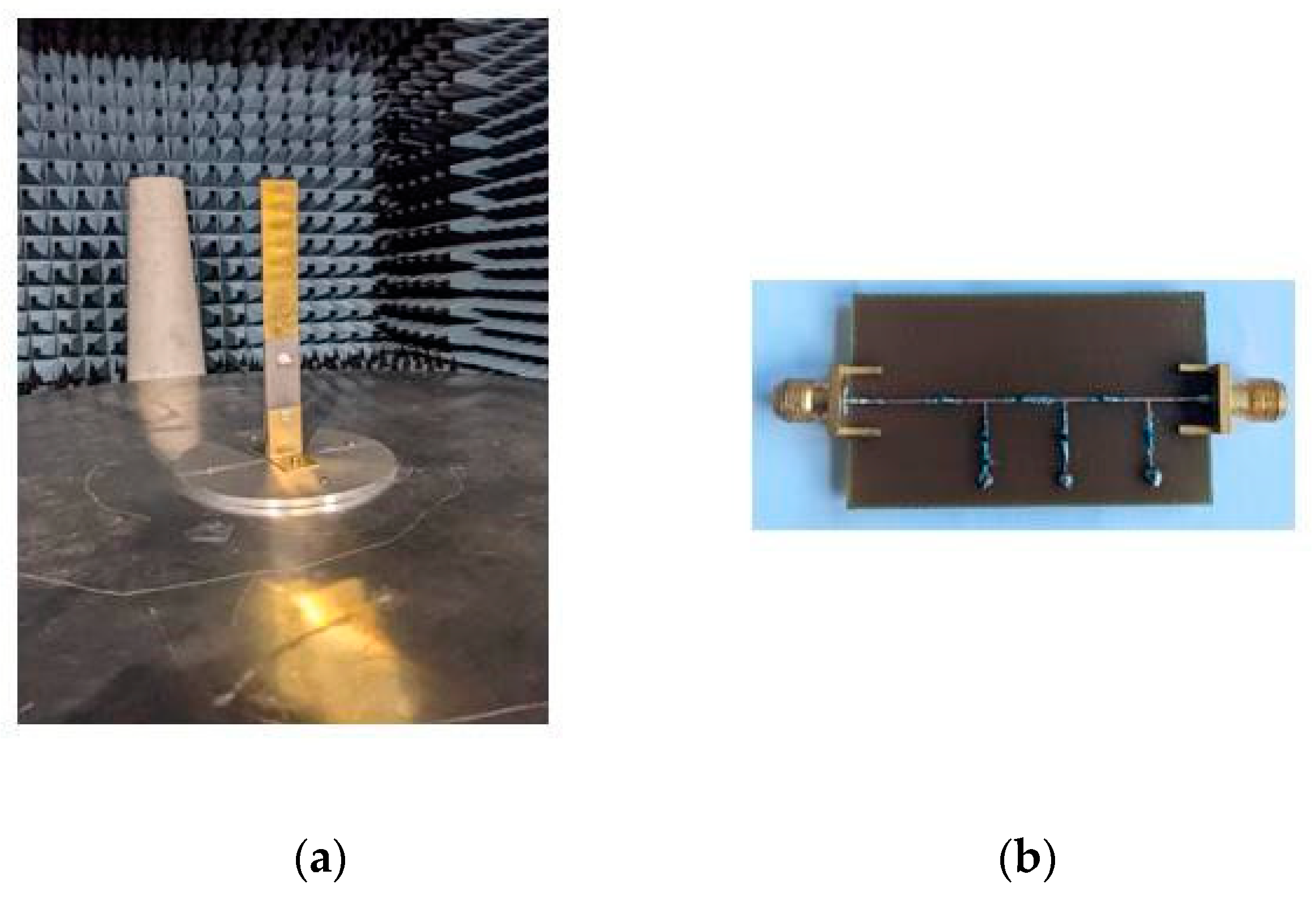

Publisher’s Note: MDPI stays neutral with regard to jurisdictional claims in published maps and institutional affiliations. |
© 2022 by the authors. Licensee MDPI, Basel, Switzerland. This article is an open access article distributed under the terms and conditions of the Creative Commons Attribution (CC BY) license (https://creativecommons.org/licenses/by/4.0/).
Share and Cite
Finet, T.; Sharaiha, A.; Tarot, A.-C.; Pouliguen, P.; Potier, P.; Le Meins, C. Monopole Antenna Miniaturization with Magneto-Dielectric Material Loading Combined with Metal Parasitic Element. Magnetism 2022, 2, 368-379. https://doi.org/10.3390/magnetism2040026
Finet T, Sharaiha A, Tarot A-C, Pouliguen P, Potier P, Le Meins C. Monopole Antenna Miniaturization with Magneto-Dielectric Material Loading Combined with Metal Parasitic Element. Magnetism. 2022; 2(4):368-379. https://doi.org/10.3390/magnetism2040026
Chicago/Turabian StyleFinet, Thomas, Ala Sharaiha, Anne-Claude Tarot, Philippe Pouliguen, Patrick Potier, and Cyrille Le Meins. 2022. "Monopole Antenna Miniaturization with Magneto-Dielectric Material Loading Combined with Metal Parasitic Element" Magnetism 2, no. 4: 368-379. https://doi.org/10.3390/magnetism2040026
APA StyleFinet, T., Sharaiha, A., Tarot, A.-C., Pouliguen, P., Potier, P., & Le Meins, C. (2022). Monopole Antenna Miniaturization with Magneto-Dielectric Material Loading Combined with Metal Parasitic Element. Magnetism, 2(4), 368-379. https://doi.org/10.3390/magnetism2040026





